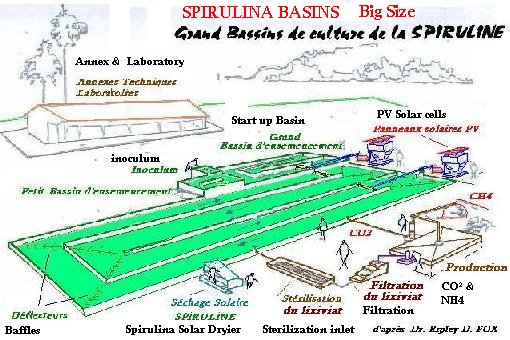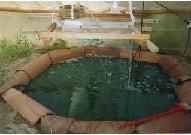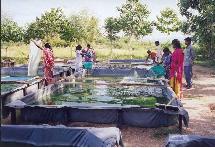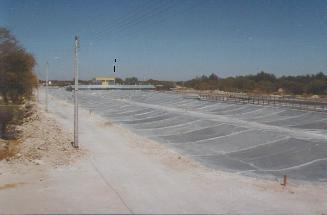
SPIRULINA alias SPIRULINE farms
http://malnutritionzero.online.fr/sub4.htm
| Spirulina grows naturally in many countries
in shallow alkaline lakes. This was the source
for the Aztecs and the Kanembous. We must
preserve the Spirulina in these lakes for
the indigenous people who consume Spirulina
and for the lesser flamingo for which it
is the principal food. We need only a cup-sized
sample from one of these lakes in order to
grow all the Spirulina we can use. Today Spirulina is produced on four different types of farm - all using the same production principles:
 GEANTS FARMS There is the GEANT FARMS for production of SPIRULINA To day there are somewhere around 30,000,000 children at high risk of death by malnutrition. To provide 10 grams of Spirulina daily to 30,000,000 children would require a yearly production of 109,500 tons - calling for at least 3000 hectares of Spirulina farms. As it would take 6 million cubic-meters of water to fill the 3000 hectares just 20 centimeters deep, and could require over 36,000,000 cubic meters more water to make up for evaporation over a year's time, . To produce this Spirulina for 30,000,000 children would equal the cost of one day of the 100-day Gulf War Again, the two texts mentioned at the end of the section on composition of Spirulina contain detailed information on this subject of giant seawater Spirulina farms. Another thing we can do for these children is to grow fish for them. The world fish catch from the oceans peaked out in 1990 but the human population continues to grow. The solution for fish on the table has been to increase the extent of landbased and seaside aquaculture. But we have been feeding these captive fish other fish we take from the sea and agricultural products grown on farms which should be used to produce food directly for humans. A stable and sustainable adjunct to ocean fishing appears to be the creation at the seaside of micro-oceans where one can duplicate all the essential links of a food chain leading from microalgae up to highly desirable pelagic table fishes, including also the harvesting of smaller fishes, crustaceans, and mollusks. We will borrow water from the ocean, grow Spirulina and Artemia in part of it but pass the bulk of it through a specially-planted mangrove forest where fish and shrimp are grown on the Spirulina and Artemia plus the concentrated and diverse bottom life and insect life which aggregates around the mangroves. When the water passes out of the mangrove forest it goes through a mollusk ranch where microalga and detritus are completely removed, allowing clean sea water to return to the sea. The micro-ocean farm yields 860 times more than the catch from an equivalent ocean area. Micro-ocean farms totalling the size of Sudan or Guinea could provide 50 million tons of high protein foods. To do the same with cattle would require a land area equivalent to China, plus the United States ! The principles of the micro-ocean farm is explained in detail in: Third Millenium Aquaculture, farming the micro-oceans, by Ripley D. Fox in Marine Cyanobacteria, Bulletin N°19 of the Institut Océanographique, Monaco, 1999. Now, how about you ? If you have ideas on how to stamp out malnutrition-undernutrition we'd like to hear about them. Let's all work on this together. Just contact : mailto:villardcl@aol.com?Subject=write to webmaster: MALNUTRITION-ZERO |






